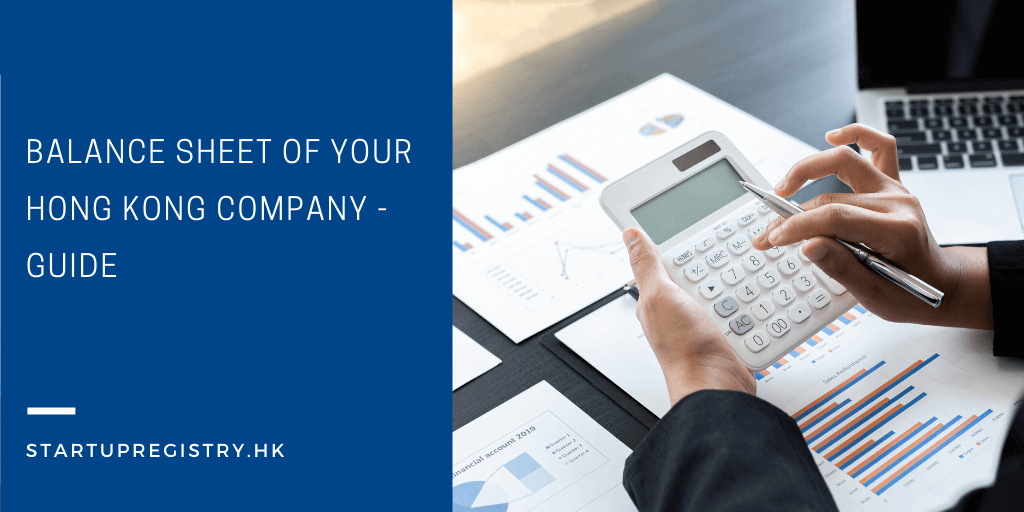A balance sheet of a Hong Kong company is one of the most critical financial statements it will produce on a quarterly or monthly basis. Representing your total assets, liabilities, and net worth, this document provides a quick look into your financial health. It can assist in informing lenders, investors, or key stakeholders about your business. In case you will need to prepare a balance sheet, keep on reading this article.

Balance Sheet
Let us dive straight into what a balance sheet is and how important it is for your Hong Kong Company.
What is a balance sheet?
A balance sheet is a financial statement that summarizes assets and liabilities of a company, and equity of shareholders at a specific point in time. It provides a foundation for computing rates of return and assessing its capital structure. It is a financial statement which offers a snapshot of what a company owns and owes and the amount invested by shareholders. The balance sheet is used besides other critical financial statements like the earnings statement and statement of cash flows in conducting fundamental analysis or calculating financial ratios.
Why is the balance sheet crucial for your Hong Kong company?
The balance sheet for Hong Kong companies is an indispensable tool used by managers, investors, investigators, and regulators to concede the current business’ financial health. Generally, it is used along side two other types of financial statements:
- the income statement and
- the cash flow statement
Balance sheets provide the user an at-a-glance view of the assets and liabilities of the company. The balance sheet can assist users in answering questions such as whether the company has a positive net worth, sufficient cash, and short-term assets to cover its obligations and whether the business is highly indebted relative to its peers.
What’s included in a balance sheet?
The balance sheet comprise the company’s information, assets, and liabilities. Based on the business, this might consist of short-term investments, like cash and accounts receivable, or long-term support, for instance, a property, plant, and equipment (PP&E). Moreover, its liabilities might include short-term obligations such as accounts payable and wages payable, or long-term liabilities such as bank loans and additional debt obligations. The balance sheet is a snapshot describing the company’s state finances at the moment in time. By itself, it cannot give a sense of the trends that are playing out over a more extended period. For this reason, you should examine the balance sheet with those of previous periods. It should also be compared with those of other businesses in the same industry, considering different industries have unique approaches to financing.
Assets
Accounts are arranged from top to bottom in order of liquidity within the assets segment. That is the ease with which they can convert them into cash. Within the assets segment, accounts are listed from top to bottom in order of their liquidity – that is, the ease with which they can convert them into cash. They are divided into current assets, which you can convert to cash in one year or less, and non-current or long-term assets, which cannot. Here is the general order of accounts within current assets:
- Cash and cash equivalents are the most liquid assets and can incorporate Treasury bills, short-term deposit certificates, and hard currency.
- Marketable securities are equity and debt protection for which there is a liquid market.
- Accounts receivable refers to money that customers owe the company, including an allowance for doubtful accounts since a certain proportion of customers can be expected not to pay.
- Inventory are goods available for sale, valued at the more inexpensive of the cost or market price.
- Prepaid expenses describe the value previously paid for, like insurance, advertising contracts, or rent.
Long-term assets include the following:
- Long-term investments are securities that cannot or will not be liquidated in the following year.
- Fixed assets involve land, machinery, buildings, and other durable, frequently capital-intensive assets.
- Intangible assets comprise non-physical but valuable assets like intellectual property and goodwill. Generally, intangible assets are only listed on the balance sheet if obtained rather than developed in-house. Thus, their value may be understated – by not including a globally recognized logo, for example – or just as wildly overstated.
Liabilities
Liabilities are the money that a company owes to outside parties, from bills it has to give to suppliers to interest on bonds it has issued to creditors to rent, utilities and salaries. Current liabilities are due within one year and are listed according to their due date. Long-term liabilities are expected at any point after one year. Current liabilities accounts might consist of:
- current portion of long-term debt
- bank indebtedness
- interest payable
- wages payable
- customer prepayments
- dividends payable and others
- earned and unearned premiums
- accounts payable
Long-term liabilities can include:
- Long-term debt: These are interest and principal on bonds issued.
- Pension fund liability: It is the money a company is required to pay into its employees’ retirement accounts.
- Deferred tax liability: taxes that have been collected but will not be paid for another year.
There are a few liabilities that are considered off the balance sheet, meaning that they will not appear on the balance sheet.
Shareholder’s equity
Shareholders’ equity is the capital attributable to a business owner, meaning its shareholders. It is also known as “net assets” since it is equivalent to the total assets of a company minus its liabilities, that is, the debt it owes to non-shareholders. Retained earnings are the net earnings a company either reinvests in the business or use to pay off debt; the rest is distributed to shareholders in the form of dividends. Treasury stock is the stock a company has repurchased. You can sell it at a later date to raise cash or reserve to repel a hostile takeover.
Many companies issue preferred stock, which is listed separately from common stock under shareholders’ equity. Preferred stock is allocated an arbitrary par value – as is common stock, in some cases – that has no bearing on the market value of the shares (often, par value is just $0.01). The “common stock” and “preferred stock” accounts are calculated by multiplying the par value by the number of shares issued.
Additional paid-in capital or capital surplus describes the amount shareholders have funded more than the “common stock” or “preferred stock” accounts, based on par value rather than market price. Shareholders’ equity is not directly correlated to the market capitalization of the company. Rather it is based on the current price of a stock. At the same time, paid-in capital is the sum of the equity that has been purchased at any cost.
Preparing a Balance Sheet
Below are the steps that you can use to prepare a balance sheet for your business. Despite the fact that some or all of the process is automated through an accounting system or software, learning how a balance sheet is prepared will permit you to spot potential errors in order to be resolved before they cause lasting damage. Follow these steps:
Identify Reporting Date and Period
The main purpose of a balance sheet is to depict the total assets, liabilities, and shareholders’ equity of a company on a specific date. Typically, the specific date is referred to as the reporting date. The reporting date will usually be the final day of the reporting period.
Most companies (mainly publicly traded ones) will report quarterly. When this is the case, the reporting date will fall on the final day of the quarter:
- Q1: March 31
- Q2: June 30
- Q3: September 30
- Q4: December 31
Companies that report annually will often use December 31 as their reporting date, though they can select any date. It’s not uncommon for a balance sheet to take a few weeks to prepare after the reporting period has ended.
Tally assets
After you have identified your reporting date and period, you will need to tally your assets as of that date. A balance sheet will typically list assets in two ways: Individual line items and total assets. Splitting assets into different line details will make it more comfortable for analysts to learn and know what your assets are and where they came from; tallying them together will be required for final analysis. A company will often split assets into the following line items:
- Current Assets:
- Cash and cash equivalents
- Short-term marketable securities
- Accounts receivable
- Inventory
- Other current assets
- Non-current Assets:
- Long-term marketable securities
- Property
- Goodwill
- Intangible assets
- Other non-current assets
Current and non-current assets should both be subtotaled and then totaled together.
Determine your liabilities
Furthermore, you will want to recognize your liabilities. Repeatedly, these should be established into both line items and totals, as below:
- Current Liabilities:
- Accounts payable
- Accrued expenses
- Deferred revenue
- Current portion of long-term debt
- Other current liabilities
- Non-Current Liabilities:
- Deferred revenue (non-current)
- Long-term lease obligations
- Long-term debt
- Other non-current liabilities
As with assets, these should be both subtotaled and then totaled together.
Find shareholders equity
If a single owner privately holds a company or organization, shareholders’ equity will generally be pretty straightforward. In case it is held publicly, this calculation may grow more complex depending on the different types of stock issued. Typical line items found in this section of the balance sheet consist of:
- Common stock
- Preferred stock
- Treasury stock
- Retained earnings
Eqvista can help you record or manage various shareholders’ equity right from the beginning of your company. With the leading cap table service and valuation service, they can assist you in managing the company effectively.
Compare total assets against total liabilities plus equity
In order to make sure that the balance sheet is balanced, it will be important to examine total assets on total liabilities plus equity. To do this, you should add liabilities and shareholders’ equity together.
Need Any Accounting Assistance for Your Hong Kong company
Balance sheets are an important part of your company in Hong Kong as it gives a quick summary of the financial health of your company. It is best for you to hire professionals to do this for you as they will make sure that the balance sheet is made without mistakes and adhere to the regulations. One such professional that can help you in such tasks is Startupr. Startupr also provides other services such as bookkeeping and accounting services, filing of the annual return form, company incorporation, mail forwarding, and more. Tools can also help make creating a balance sheet easier. Eqvista is a platform backed by professionals that provides you with tools to assist you in recording and managing your company’s shareholders and equity transactions.


